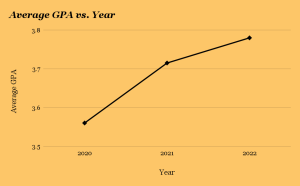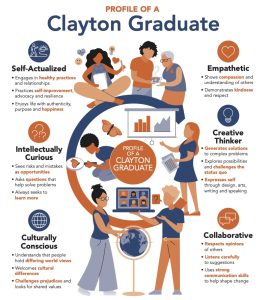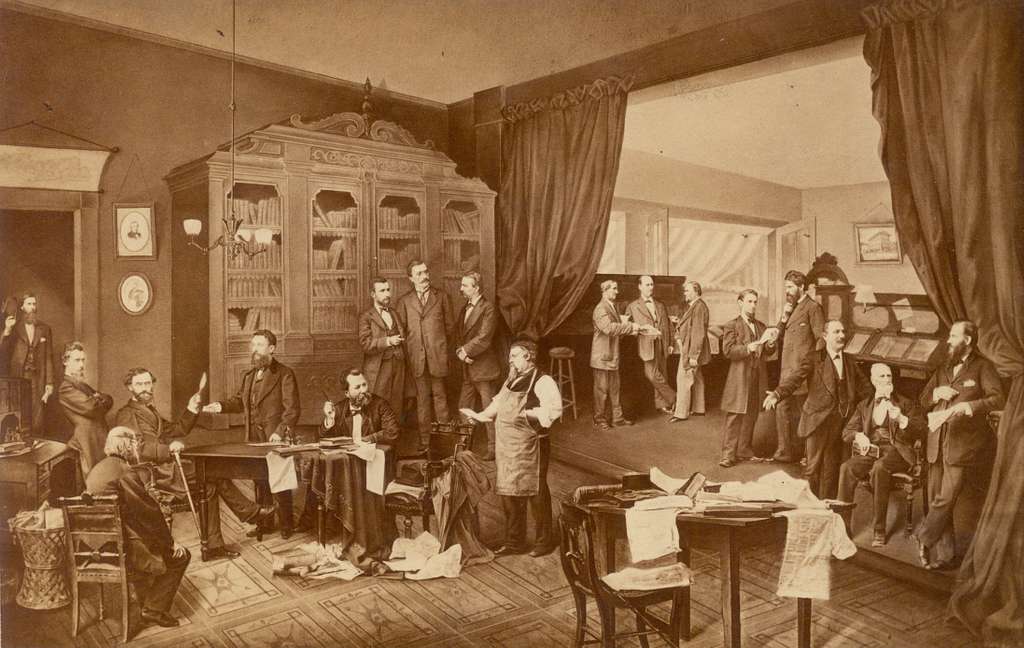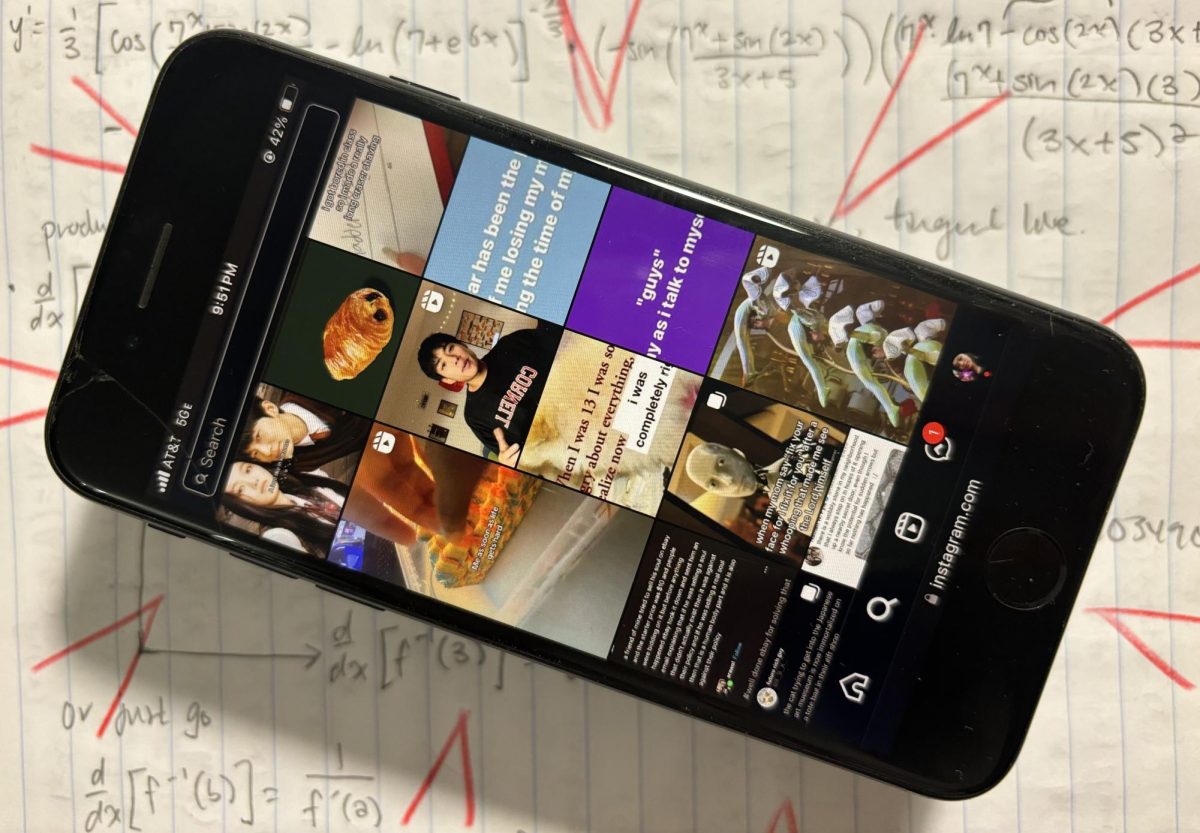Consider the figure 3.78, the mean cumulative GPA of the class of 2022, as per the Clayton Education Foundation Annual Gratitude Report.
3.78 — that GPA resides comfortably within the upper levels of academic achievement, signaling a repertoire of A grades, perhaps with a smattering of A-minuses, as the numerical equivalents for letter grades on a 4.0 scale are 4.0 for an A and 3.7 for an A-.
Now, contrast this number with the class of 2020’s mean cumulative GPA of 3.56, still a commendable figure placing the average grade between a B+ and an A- on the standard 4.0 scale. Is it plausible that the average student falls within the B+ to A spectrum?

Does Clayton, then, grapple with grade inflation? The situation may not be as dire as it seems.
While it’s tempting to attribute the GPA increase solely to more lenient grading practices post-pandemic, the longstanding ‘A+ boost,’ which I believe Clayton should abolish, remains the most significant contributor to a high GPA.
Firstly, Clayton bestows a 4.3 GPA for an A+. If a 4.0 is traditionally desirable (whatever that means), a diligent sprint through a PE class can offset an A- “blemish.” Do I desire the boost? Maybe. It isn’t authentic, though. College admission officers scrutinize core subjects, including science, math, English, social sciences and languages, while relegating extraneous grades in PE, health and arts courses to the periphery, so the A+ boost doesn’t really help students.
Of course, achieving an A+ in core classes does remain within the realm of possibility. However, there’s no imperative to supplement these A+s with a boost — the A+ can retain its place on the transcript as an additional distinction for the considerable effort invested in securing that stellar grade.

We must realize that our GPAs are tethered to a 4.3 scale. While a select few may ardently pursue the pinnacle of a 4.3, for the majority, the A+ boost serves as a mere pacifier, an ego booster and a palliative to satiate the appetite for a higher GPA.
Ultimately, the A+ boost casts a shadow on the institution’s credibility — given the ludicrous elevation of our average GPA — and unfolds issues surrounding the pursuit of perfection.
Aside from a few classes during my freshman year, I “only” got As in my classes. When I heard other students getting a 4.3, my As felt like deflated ping pong balls. Fueled by a potent mix of ambition and anxiety the next semester, I clawed my way to a perfect A+ report card — even in English class. Yes, this was the pressure cooker of high school life (at least in my privileged, Ivy-obsessed corner of suburbia) — the A+ arms race.
Such anecdotes, while absurd, resonate among students who want to be perfect in everything they do.
“Students are vigilant in respect to verifying the accuracy of their scores on assignments and assessments,” AP Biology teacher Adam Bergeron said.
According to Bergeron, some even tend to be hostile and disrespectful when engaging with their educators in their relentless pursuit of academic points.
“[Students] debating with a teacher to justify why they scored an assignment the way that they did is one of the most distasteful aspects of being a teacher today. We are professionals. We deserve respect,” Bergeron said.
The relentless quest for perfection also becomes entangled with one’s sense of self-value.
“Unfortunately, I think students’ motivation to perform well at school is directly tied to their feelings of self-worth,” Bergeron said. “‘If I do well, then I am a good person. My parents will love me, and/or my parents won’t be disappointed in me. If I don’t (or can’t) perform at a high level, then there must be something wrong with me.’”
Students have a lot on their plates.
The college admissions landscape has shifted, making entry more competitive. While strong academic performance remains crucial, “holistic review” has become the dominant approach, emphasizing factors beyond the classroom, according to a paper by Coleman and Keith for the College Board.
This means studying for countless hours, a strategy many high-achieving Clayton students employed in the past, is no longer sufficient. Today’s applicants are expected to demonstrate a well-rounded profile through diverse activities such as leadership roles, musical pursuits and academic competitions to get somewhere.
Thus, the adoption of more non-traditional grading policies is where I stand in support of what some may label as grade inflation. Clayton has dedicated several preceding years to a concentrated exploration of equity — an initiative that persists. A third of the Clayton staff engaged in two book studies delving into the intricacies of grading, which aimed to explore ways to render grades more accurate and impervious to bias.
“From a mathematical perspective, the long-standing traditional 100-point grading system was disproportionately weighted toward failure, with four 10-point increments for ‘passing’ and 60 increments for failure,” Craig Sucher, science teacher and Academic and School Improvement Chair, said. “When a student was present for the learning and did not complete the associated assignment, we know that the student learned something toward the standard greater than zero. Recording a zero for the grade was inaccurate.”
If these policies are deemed as such, then yes, I endorse the concept of grade inflation. Does that mean schools should counterbalance this omnipresence of obligations by adopting late work policies? No, I don’t think so. However, an organic response seems to be a more equitable stance on grading policies, especially when the relentless weight of expectations enacts a toll on students’ mental well-being.
“Moving away from recording a zero for missing assignments has had the greatest impact on student motivation,” Sucher said. “I have seen instances with my students where our current system has supported [the] best path toward success in those instances where life gets in the way.”
Dr. Marc Brackett, director of the Yale Center for Emotional Intelligence and professor at the Yale Child Study Center, developed the “Mood Meter” in 2005 to recognize and understand emotions. This tool allows individuals to self-assess their energy and pleasantness levels, guiding them toward identifying the specific emotion they are experiencing.
In his classroom, Bergeron uses the Mood Meter and other socio-emotional learning tools to gauge students’ emotional states. By leveraging PearDeck education tools, students can drag their dots onto their present emotions. Bergeron can then gather student data for later analysis while displaying the results in real-time for the entire class.
“I cannot disaggregate a student’s position on the mood meter, so I try to look at the ‘big picture.’ I think it is safe to say that students tended to respond more negatively on the mood meter,” Bergeron said. “We know that one’s emotional state influences their cognitive state; if students aren’t ready to learn, they won’t. Period. It’s not an accident that we are — and have been — in the midst of an adolescent mental health crisis. Until we reckon with the role of academics in this crisis, I’m not sure we will ever find our way out.”
Some say that lenient grading, specifically accepting late work, fails to prepare students for college, a perspective deemed valid. However, it is crucial to recognize that high school, fundamentally, is just that — high school, a realm where one can revel in mistakes and navigate the folly of teenage years. The advocacy for lenient grading, though not intended to be a perpetual stance, becomes imperative until assurance is gained that students find themselves in optimal mental states, especially in a place like Clayton — and especially in a nation undergoing a youth mental health crisis.
“A much bigger positive impact on our school’s academic culture and the way students approach their studies is the opportunity for re-learning and re-assessment,” Sucher said. “This actionably demonstrates our commitment to a growth mindset. When learners apply themselves maximally and fall short of achieving the standard, the opportunity to apply themselves again and achieve what they had not previously is a discipline and skill that will serve all future life endeavors.”

In crafting a Clayton graduate profile, one of the district’s elusive goals is self-actualization — a state epitomized by physical and mental well-being and unwavering self-belief.
To cultivate this paradigm, Clayton must relinquish the burdens of perfection, epitomized by the redundant 4.3. This shift would also redefine excellence, separating it from the perfection of GPA, and emphasize genuine curiosity while considering “risks and mistakes” as chances to learn and progress.
Additionally, a compassionate understanding of students’ challenges in their academic journey is imperative. Clayton can empower students to become well-rounded, self-actualized individuals through this simple equilibrium.
“We knew the magnitude of the challenge [of implementing these changes] and the significant benefit to our students,” Sucher said. “Our commitment to learners aligned with our commitment to the vision of the Profile of the Graduate fueled our perseverance.”
Ultimately, pursuing “good grades” doesn’t define my existence. Why should my concern linger on colleges that might reject me based on the inherent flaws that accompany my human existence?
If being deemed flawless is a prerequisite for an institution, then I’m not inclined to invest my money in it. If emphasizing my mental well-being entails doing “less” or participating in fewer extracurricular activities than my peers, so be it — that doesn’t diminish my worth or dedication as a hard worker.










